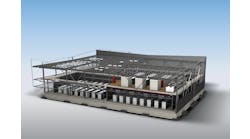It’s a short statement, deep inside a lengthy review of innovation in Facebook’s digital infrastructure. But for anyone who knows the data center industry, it’s a real eye-opener.
“As I’m writing this, we have 48 active buildings and another 47 buildings under construction,” said Tom Furlong, President of Infrastructure, Data Centers at Meta (formerly Facebook). “So we’re going to have more than 70 buildings in the near future.”
The statement reflects the extraordinary scope of Meta’s global infrastructure expansion. The company has 18 data center campuses around the world, which upon completion will span 40 million square feet of data center space.
Having 47 buildings under construction would be a challenge in any circumstances, but particularly so during a global pandemic and supply chain disruption. It’s not easy, or cheap. Meta says it expects to invest between $29 billion and $34 billion in capital expenditures in 2022, up from $19 billion last year.
It’s not alone, as the largest hyperscale operators are pouring billions of dollars into expanding their data center infrastructure to meet demand for their digital services. Hyperscale capital expenditures were up 30 percent in the first half of 2021, according to an analysis from Synergy Research Group, which tracks 19 hyperscale providers who spent about $83 billion in the six-month period.
Those spending levels could easily increase, in light of Facebook’s projections on future capex spending and Microsoft’s plans to build 50 to 100 data centers a year.
Infrastructure Innovation at Epic Scale
Furlong’s blog post about Meta’s data center journey is worthwhile reading, as is a companion post that looks back at the progress of the Open Compute Project, the open hardware initiative founded by Facebook in 2011.
“Open hardware drives innovation, and working with more vendors means more opportunity to develop next-generation hardware to support current and emerging features across Meta’s family of technologies.,” Furlong writes.
The need to innovate at scale has also including data center construction.
“There is a lot of activity in the data center and construction industries today, which puts pressure on us to find the right sites and partners,” said Furlong. “It also means we need to create more flexible site selection and construction processes. All this effort also involves looking at our vendors and contractors more as partners in all this. We can’t just make this about dollars. We have to make it about performance. We have to make it about driving best practices and continuous improvement.
“But that’s not the way the construction industry typically works,” he continued. “So, we’ve had to bring a lot of our own ideas about running operations and making improvements and impress them on the companies we work with.”
Digital infrastructure is becoming more important every day, and Meta and its hyperscale counterparts are pioneering new strategies to deliver the scale and speed they need. It’s an ongoing process, as Furlong reflects.
“Moving into the data center arena was never going to be easy,” he writes. “But I think we’ve ended up with an amazing program at a scale that I never, ever would have imagined. And we’re always being asked to do more. That’s the business challenge, and it’s probably one of the main things that keep me and my team coming in to work every day. We have this enormous challenge ahead of us to do something that is unbelievably massive at scale.”






